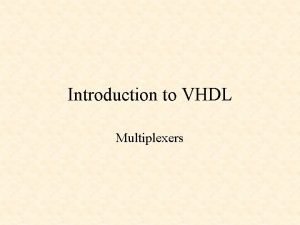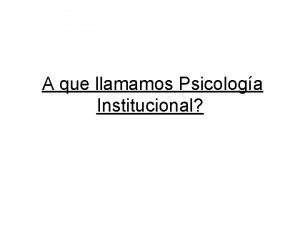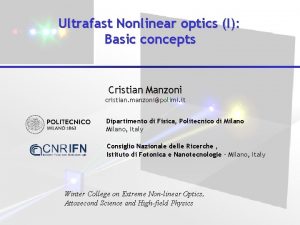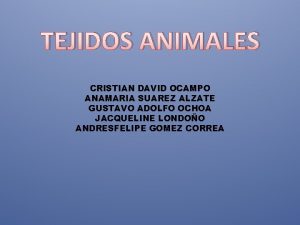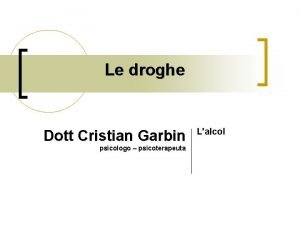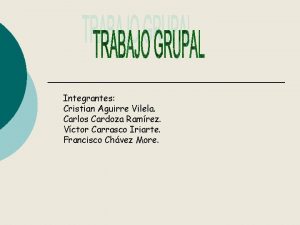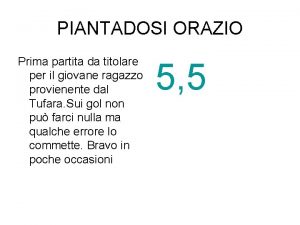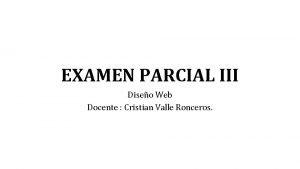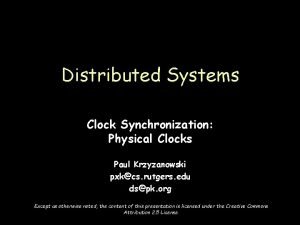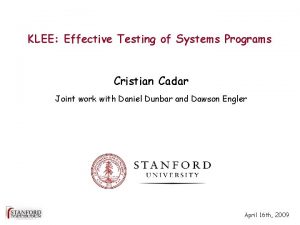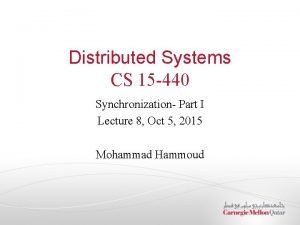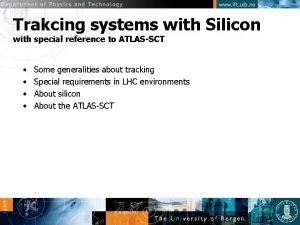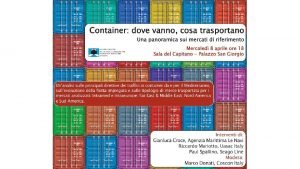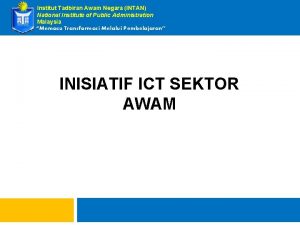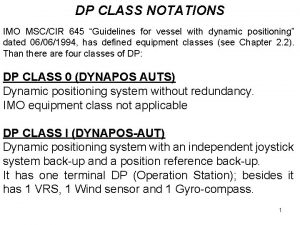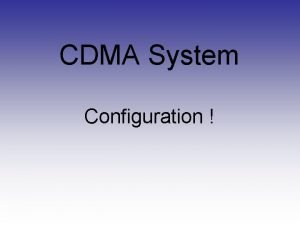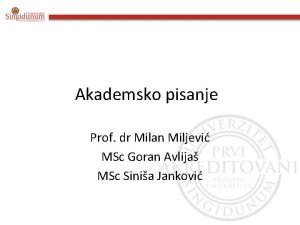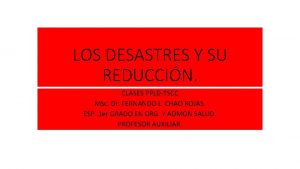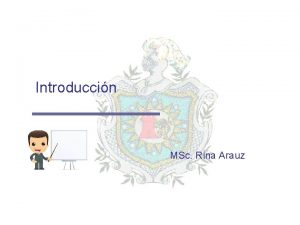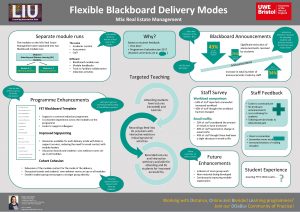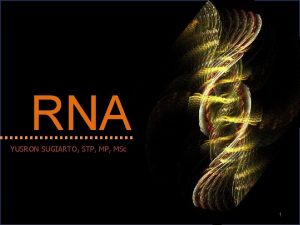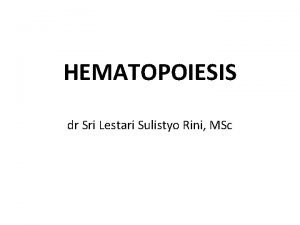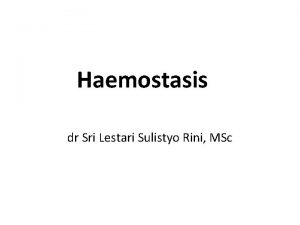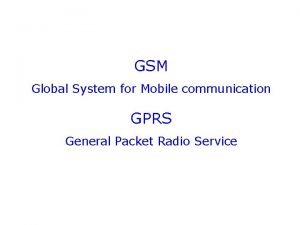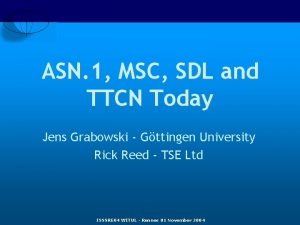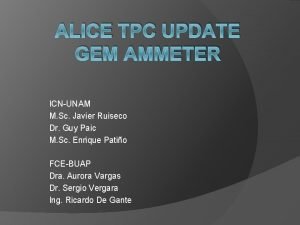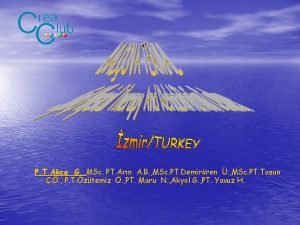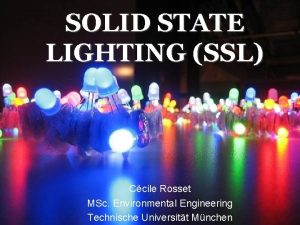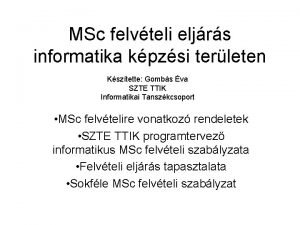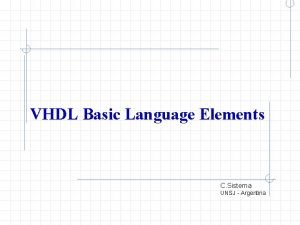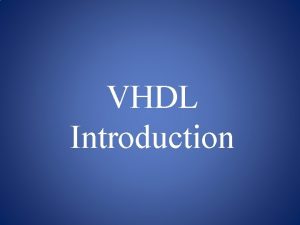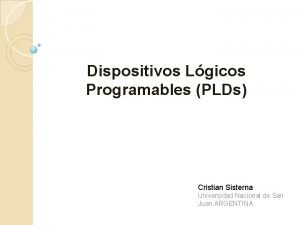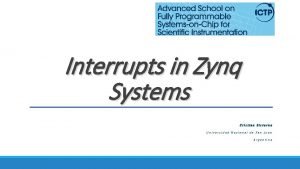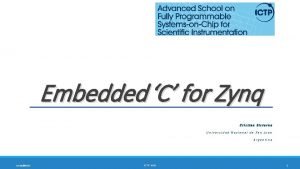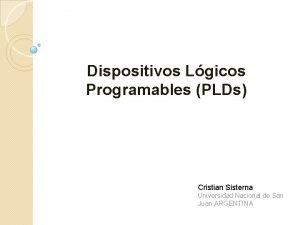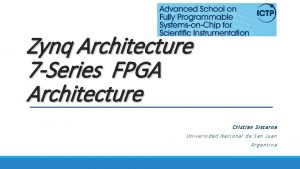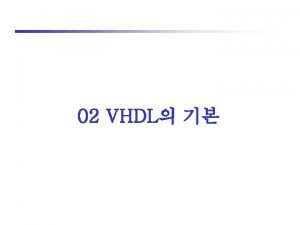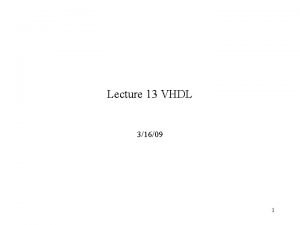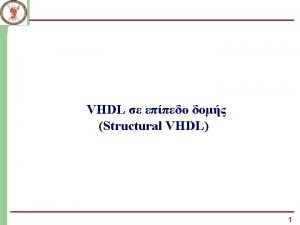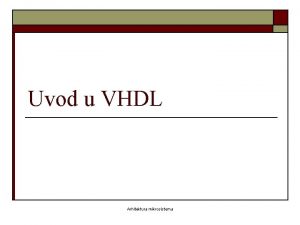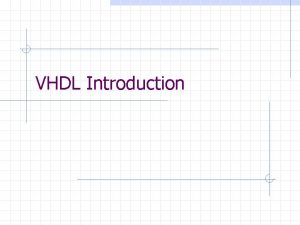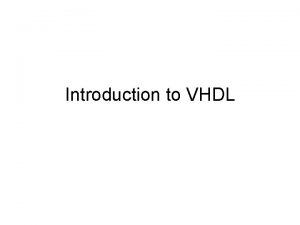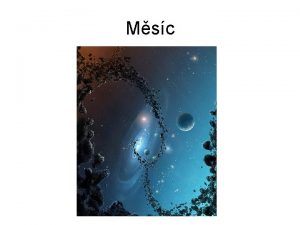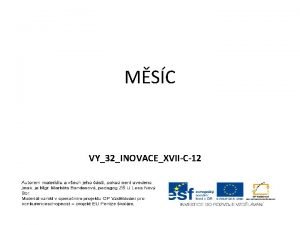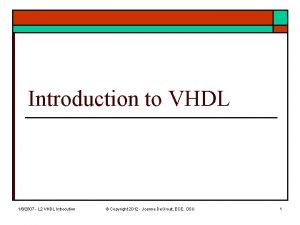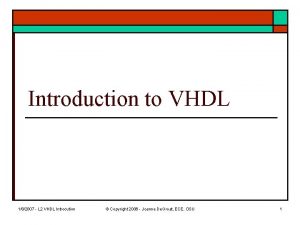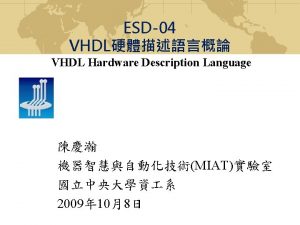VHDL Introduction MSc Cristian Sisterna UNSJ Introduction Very































































![Process Statement �Syntax process sensitivity_list [declarations; ] begin sequential_statements; end process; 64 DSDA - Process Statement �Syntax process sensitivity_list [declarations; ] begin sequential_statements; end process; 64 DSDA -](https://slidetodoc.com/presentation_image/2ddf167a70142c475ed8688c831062fa/image-64.jpg)
![Process Statement [process_label: ] process [(sensitivity_list)] [is] [process_data_object_declarations] begin variable_assignment_statement signal_assignment_statement wait_statement if_statement case_statement Process Statement [process_label: ] process [(sensitivity_list)] [is] [process_data_object_declarations] begin variable_assignment_statement signal_assignment_statement wait_statement if_statement case_statement](https://slidetodoc.com/presentation_image/2ddf167a70142c475ed8688c831062fa/image-65.jpg)




![if Statement �Syntax if <boolean_expression> then <sequential_statement(s)> [elsif <boolean_expression> then <sequential_statement(s)>] . . . if Statement �Syntax if <boolean_expression> then <sequential_statement(s)> [elsif <boolean_expression> then <sequential_statement(s)>] . . .](https://slidetodoc.com/presentation_image/2ddf167a70142c475ed8688c831062fa/image-70.jpg)






![case Statement [case label: ]case <selector_expression> is when <choice_1> => <sequential_statements> -- branch #1 case Statement [case label: ]case <selector_expression> is when <choice_1> => <sequential_statements> -- branch #1](https://slidetodoc.com/presentation_image/2ddf167a70142c475ed8688c831062fa/image-77.jpg)





![for-loop Statement [loop_label]: for identifier in discrete_range loop <sequential_statements> end loop [loop_label]; <identifier> • for-loop Statement [loop_label]: for identifier in discrete_range loop <sequential_statements> end loop [loop_label]; <identifier> •](https://slidetodoc.com/presentation_image/2ddf167a70142c475ed8688c831062fa/image-83.jpg)















- Slides: 98

VHDL Introduction MSc Cristian Sisterna UNSJ

Introduction Very High Speed ICs Hardware Description Language 2 DSDA - © 2016 V H D L C. Sisterna

Hardware Description Language Ø High level of abstraction if(reset=‘ 1’) then count <= 0; elsif(rising_edge(clk)) then count <= count+1; end if; Ø Easy to debug Ø Parameterized designs Ø Re-uso Ø IP Cores (free) available 3 DSDA - © 2016 C. Sisterna

HDL Synthesis Sub-Set Used to write code to simulate the behavior of a design VHDL Synthesizable 4 Used to implement the design into hardware (for instance in FPGA) DSDA - © 2016 C. Sisterna

VHDL ‘Description’ Examples x y sel 0 1 z if(sel=‘ 1’) then z <= y; else z <= x; end if; z <= y when sel=‘ 1’ else x; 5 DSDA - © 2016 C. Sisterna

VHDL – Module Structure mux 2 x 1. vhd entity x y I/O 0 1 sel 6 DSDA - © 2016 z architecture Functionality C. Sisterna

VHDL Module Structure mux 2 x 1. vhd entity mux 2 x 1 is port( x, y, sel: in std_logic; z : out std_logic); end mux 2 x 1; x y 0 1 sel 7 DSDA - © 2016 z architecture test of mux 2 x 1 is begin process(x, y, sel) begin if(sel=‘ 1’) then z <= y; else z <= x; end if; end process; end test; C. Sisterna

VHDL Module Structure mux 2 x 1. vhd entity mux 2 x 1 is port( x, y, sel: in std_logic; z : out std_logic); end mux 2 x 1; x y 0 1 sel 8 z architecture test of mux 2 x 1 is begin z <= y when sel=‘ 1’ else x; end test; DSDA - © 2016 C. Sisterna

VHDL Code – Is it really Works? ? Test Bench Stimulus Signals 9 DSDA - © 2016 Unit Under Tested Signals C. Sisterna

VHDL – Simulation / Verification 10 DSDA - © 2016 C. Sisterna

VHDL - Synthesis VHDL Code with tmp select j <= w when “ 1000”, x when “ 0100”, y when “ 0010”, z when “ 0001”, '0‘when others; Design Constraints NET CLOCK PERIOD = 50 ns; NET LOAD LOC = P Design Attributes Synthesis Tool FPGA list of Components and Connections attribute syn_encoding of my_fsm: type is “one-hot”; FPGA Library of Components 11 Cyclone Spartan DSDA - © 2016 C. Sisterna

VHDL-FPGA Design Flow 12 DSDA - © 2016 C. Sisterna

Design Implemented in the FPGA 13 DSDA - © 2016 C. Sisterna

FPGA Kit – DE 2 -115 http: //www. terasic. com. tw/cgi-bin/page/archive. pl? Language=English&Category. No=165&No=502 14 DSDA - © 2016 C. Sisterna

VHDL Objects 15 DSDA - © 2016 C. Sisterna

Identifiers A basic identifier: May only contain alphabetic letters (A to Z and a to z), decimal digits (0 to 9) and the underline character (_) Must start with an alphabetic letter May not end with an underline character May not include two successive underline characters VHDL is not case-sensitive No blank space(s) are allowed Examples: Same identifier Txclk, Tx. Clk, TXCLK, Tx. CLK Legal identifiers Rst, Three_State_Enable, CS_244, Sel 7 D Illegal identifiers _Set, 80 X 86, large#bits, m__RAM, add_ 16 DSDA - © 2016 C. Sisterna

Objects A object holds a value of some specified type and can be one of the three classes Declaration Syntax: object_class <identifier> : type [ : = initial_value]; Class signal variable constant 17 DSDA - © 2016 Object identifier Type boolean std_logic/std_ulogic std_(u)logic_vector unsigned C. Sisterna

Objects Each object has a type and a class The type indicates what type of data can be hold by the data object The class indicates what can be done with the data object Constant Variable constant setup_time: time : = 3 ns; variable flag: boolean : = true; variable add_bus: std_logict_vector (12 downto 0); Classes Signal 18 constant data_bus: integer : = 32; signal reset : bit; signal my_start_up: std_logic; File DSDA - © 2016 C. Sisterna

Signal Declaration - Architecture Signal Declarations: A signal is declared in the declarative part of an architecture signal count_i: std_logic; Signal Name (identifier) 19 DSDA - © 2016 Signal Type boolean std_logic/std_ulogic std_(u)logic_vector unsigned integer C. Sisterna

Signal Declaration Entity Port declarations appear in the port section of an entity declaration. Each port declaration is seperated by semicolon from the others A port declaration has three parts: signal reset_n: in std_logic; Signal Name 20 Port Mode in out inout buffer DSDA - © 2016 Signal Type boolean std_(u)logic_vector unsigned integer C. Sisterna

Signal Declaration – Ports in the Entity 21 DSDA - © 2016 C. Sisterna

Signal Assignment count <= count + 1; carry_out <= (a and b) or (a and c) or (b and c); Z <= y; Left Hand Side (LHS) Target Signal LHS Signal Type 22 DSDA - © 2016 Right Hand Side (RHS) Source Signal(s) RHS Signal Type C. Sisterna

Signal – How to read an output An output port declared as mode out can not be read How to solve this problem? entity and_nand is port( a, b : in std_logic; entity and_nand is z, z_bar: out std_logic); port( end; a, b: in std_logic; z, z_bar: out std_logic); architecture bad of and_nand is end; begin z <= a and b; architecture bad of and_nand is z_bar <= not z; signal int_sig: std_logic; end; begin int_sig <= a and b; z <= int_sig; z_bar <= not int_sig; end; 23 DSDA - © 2016 C. Sisterna

Constant Declaration An Object of class constant holds a single value of a specific type The value is assigned to the constant during its declaration and the value can not be changed Constant declaration: constant <identifier>: type : = value; 24 DSDA - © 2016 C. Sisterna

Constant Declarations architecture behavioral of counterx 16 is constant Bus_Width: integer : = 16; constant GNDLogic: bit : = '0'; constant error_flag: boolean : = true; constant cnt_max: std_logic_vector(3 downto 0): =“ 1111”; signal count_tmp: std_logic_vector(3 downto 0); begin 25 DSDA - © 2016 C. Sisterna

VHDL Operators 26 DSDA - © 2016 C. Sisterna

Logic Operators 27 DSDA - © 2016 C. Sisterna

Boolean or Logic Operators � All boolean operators have the same precedence Parenthesis must always be used to separate out the different boolean operators in an expression carry <= a and b or a and c or b and c; -carry <= (a and b) or (a and c) or (b and c); -- The only exception is the not operator zout <= not a and b; -- equivalent to zout <= (not a) and b; 28 DSDA - © 2016 C. Sisterna

Boolean or Logic Operators The inversion operands nand nor are not associative y 1 <= a nand b nand c; -- illegal y 1 <= (a nand b) nand c; -y 1 <= a nand (b nand c); -- Non inversion operands are associative parity <= d 0 xor d 1 xor d 2 xor d 3 xor d 4 xor d 5 xor d 6 xor d 7; 29 DSDA - © 2016 C. Sisterna

Relational Operators 30 DSDA - © 2016 C. Sisterna

Relational Operators �All types have equality and inequality operators The result of relational operators is boolean type Boolean operators can be used with relational operators data <= a=0 and b=1; -- data is type? Relational operatos have higher precedence than boolean operators. However, it is a good VHDL style coding to use parenthesis: data <= (a=0) and (b=1); 31 DSDA - © 2016 C. Sisterna

Mathematical Operators 32 DSDA - © 2016 C. Sisterna

Mathematical Operators 33 DSDA - © 2016 C. Sisterna

Operators, Precedence 1 – Miscellaneous 2 – Multiplying 3 – Sign 4 – Adding 5 – Relational 6 – Logical ** , abs, not *, / , mod, rem +, +, -, & = , /=, <, <=, >, >= and, or, nand, nor, xor 3+4*5=? 3 – 4 + 5 = (3 – 4) + 5 = 4 y <= 2 * x ** 2 + -3 * x + -4; y <= (2 *(x ** 2)) +( -(3 * x)) + (-4); 34 DSDA - © 2016 C. Sisterna

Exercise 35 DSDA - © 2016 C. Sisterna

VHDL Types 36 DSDA - © 2016 C. Sisterna

VHDL Objects and Types signal data_a: std_logic; signal data_b: bit; Object Class Type data_a <= data_b; 37 DSDA - © 2016 C. Sisterna

Boolean Type The VHDL standard defines boolean type as follow: type boolean is (false, true); Type boolean is the built-in comparison type in VHDL All the comparison results are of boolean type 38 DSDA - © 2016 C. Sisterna

Boolean Type signal sys_on : std_logic; signal sys_off: std_logic; . . . if (sys_on = sys_off) then std_logic boolean variable bandera: boolean; signal a, b : std_logic; . . bandera : = a < b; -- ? bandera : = a ; -- ? 39 DSDA - © 2016 C. Sisterna

std_logic Type PACKAGE std_logic_1164 IS ------------------------ -- logic state system (unresolved) ------------------------ TYPE std_ulogic IS ( 'U', -- Uninitialized 'X', -- Forcing Unknown '0', -- Forcing 0 '1', -- Forcing 1 'Z', -- High Impedance 'W', -- Weak Unknown 'L', -- Weak 0 'H', -- Weak 1 '-' -- Wild card ); SUBTYPE std_logic IS resolved std_ulogic; 40 DSDA - © 2016 C. Sisterna

Integer Type An integer type defines a type whose set of values fall within a specified integer range Minimum range –(231 -1) to +(231 -1) VHDL standard defines integer type as follow: type integer is range -2147483648 to +2147483747; 41 DSDA - © 2016 C. Sisterna

Integer Type �Examples constant number_of_bits: integer : = 32; signal count: integer range 0 to 15; constant max_count: integer : = 15; signal bus_width: std_logic_vector(number_of_bits-1 downto 0; signal loads: integer; 42 DSDA - © 2016 C. Sisterna

Array: Composite Type An array is a collection of values that belongs to the same type Examples: type ADDRESSES is array (0 to 63) of bit; type DATA_WORD is array (7 downto 0) of std_ulogic; type ROM is array (0 to 15) of DATA_WORD; signal data_bus: std_logic_vector(15 downto 0); 43 DSDA - © 2016 C. Sisterna

Array: Composite Type An elements of an array can be accessed by specifying the value of the index in the array -- ADDRESSES(15) -> 16 th element of the array add_bit_16 <= addresses(15); Specific elements of an array can be accessed by specifying the range of the index in the array addr_middle_range <= addresses(16 to 31); addr_high_range <= addresses(32 to 63); addr_low_range <= addresses(0 to 15); 44 DSDA - © 2016 C. Sisterna

Array concatenation There is on operator only dedicated to be used with arrays The Concatenation Operator: & & concatenates two array to form a longer array in any of the following ways: Concatenate two arrays Concatenates one array with one element Concatenates one element with one array Concatenates two elements to form one array 45 DSDA - © 2016 C. Sisterna

Array Concatenation signal OP_CODE: std_logic_vector (1 to 5); signal My_CODE: std_logic_vector (5 downto 1); signal Final_Code: std_logic_vector ( ? ? ? ); signal ONE_Bit: std_logic; signal ONE_Nibble: std_logic_vector(3 downto 0); OP_CODE <= My_CODE; OP_CODE <= My_CODE & ONE_Bit; -- ? ? OP_CODE <= My_CODE(? ) & ONE_Bit; --? ? Final_Code <= OP_CODE & My_CODE; -- ? ? one_nibble <= op_Cod. E(1) & ‘ 0’ & OP_CODE(5) & FINAL_CODE(3); 46 DSDA - © 2016 C. Sisterna

Array Examples signal BUS: std_logic_vector (0 to 7): = X”AA”; signal MINI_BUS: std_logic_vector (0 to 4); signal CODIGO: std_logic_vector (1 to 5); signal OPERACION: std_logic_vector (5 downto 1); signal OP_CODE: std_logic_vector (1 to 5); MINI_BUS <= BUS(0 to 4); -- array slices BUS <= MINI_BUS & “ 0101”; -- & concatenation operator MINI_BUS <= ‘ 0’ & BUS(0) & BUS(4 to 5); -- right? if (MINI_BUS(0)= BUS(0)) then. . . 47 DSDA - © 2016 C. Sisterna

Type Conversion - Casting VHDL does allow restricted type CASTING, that is converting values between related types datatype <= type(data_object); signal max_rem: unsigned (7 downto 0); signal more_t: std_logic_vector( 7 downto 0); max_rem <= more_t; max_rem <= unsigned(more_t); unsigned and std_logic_vector are both vectors of the same element type, therefore it’s possible a direct conversion When there is not relationship a conversion function is used 48 DSDA - © 2016 C. Sisterna

Type Conversion - Functions VHDL does have some built-in functions to convert some different data types (not all the types allow conversions) datatype <= to_type(data_object); signal internal_counter: integer range 0 to 15; signal count: std_logic_vector( 3 downto 0); count <= internal_count; Co. Un. T <= std_logic_vector(to_unsigned(internal_count, 4)); Function converts integer to unsigned Cast to slv 49 unsigned slv DSDA - © 2016 C. Sisterna

Type Conversion – Cast / Function 50 DSDA - © 2016 C. Sisterna

Describing Combinational Logic with VHDL 51 DSDA - © 2016 C. Sisterna

Selective Signal Assignment Statement Syntax with <selection_signal> select target_signal <= <expression> when <value 1_ss>, <expression> when <value 2_ss>, . . . <expression> when <last_value_ss>, <expression> when others; A selective signal assignment describes logic based on mutually exclusive combinations of values of the selection signal 52 DSDA - © 2016 C. Sisterna

Selective Signal Assignment Statement • There is no priority. Each branch has identical priority • All values of <selection_signal> must be listed in the when clauses and will be mutually exclusive • All the possible values of the expression are reachable • A branch can depend on a range of the possible values of <selection_signal> 53 DSDA - © 2016 C. Sisterna

Selective Signal Assignment Statement Example: Truth Table “|” means OR only when used in “with” or “case” ‘-’ means don’t care 54 DSDA - © 2016 library ieee; use ieee. std_logic_1164. all; entity TRUTH_TABLE is port(A, B, C: in std_logic; Y: out std_logic) ; end TRUTH_TABLE; architecture BEHAVE of TRUTH_TABLE is signal S 1: std_logic_vector(2 downto 0); begin S 1 <= A & B & C; -- concatenate A, B, C with S 1 select Y <= ‘ 1’ when “ 000” | “ 010” | “ 100” , ‘ 0’ when “ 001” | “ 011” | “ 101”, ‘-’ when others; end BEHAVE; C. Sisterna

Selective Signal Assignment Statement Synthesis Result RTL View 55 FPGA Technology View DSDA - © 2016 C. Sisterna

Selective Signal Assignment Statement 56 W 0 0 0 0 1 1 1 1 X 0 0 0 0 1 1 1 1 Y 0 0 1 1 DSDA - © 2016 Z 0 1 0 1 digit_f 1 0 0 0 1 1 1 0 0 0 0 library ieee; use ieee. std_logic_1164. all; entity digit_f_7_seg is port(w, x, y, z: in std_logic; digi_f: out std_logic) ; end digit_f_7_seg ; architecture behave of digit_f_7_seg is signal S 1: std_logic_vector(3 downto 0); begin S 1 <= w & x & y & z; with S 1 select digit_f <= ‘ 1’ when “ 0000”|“ 0101”|” 0110”|” 1001”, ‘ 0’ when others; end behave ; C. Sisterna

4 -Inputs, 8 -bit Multiplexer library ieee; use ieee. std_logic_1164. all; entity mux 4 in 8 b is port(sel : in std_logic_vector(1 downto 0); A, B, C, D: in std_logic_vector(7 downto 0); y_out : out std_logic_vector(7 downto 0) ); end mux 4 in 8 b ; architecture behave of mux 4 in 8 b is begin with select y_out <= A when “ 00”, (other=>‘-’) when others; end behave ; 57 DSDA - © 2016 C. Sisterna

Conditional Signal Assignment Syntax target_signal <= <expression> when <boolean_condition> else . . <expression> when <boolean_condition>[else <expression>]; A conditional signal assignment describes logic based on unrelated boolean_conditions, the first condition that is true the value of expression is assigned to the target_signal 58 DSDA - © 2016 C. Sisterna

Conditional Signal Assignment expression boolean_condition z <= (a xor b) when mux_s = ‘ 0’ else b; • Assign a value to the target signal based on a condition <boolean_condition> • There is an explicit priority • <expression> and <boolean_condition> are the sensitivity list of this statement • Each <boolean_condition> is independent from the others 59 DSDA - © 2016 C. Sisterna

Conditional Signal Assignment Main usage dbus <= data when enable = ‘ 1’ else ‘Z’; dbus <= data when enable = ‘ 1’ else (others=>‘Z’); 60 DSDA - © 2016 C. Sisterna

Conditional Signal Assignment library ieee; use ieee. std_logic_1164. all; entity MY_TRI is generic(bus_ancho: integer : = 4); port( A : in std_logic_vector(bus_ancho-1 downto 0); EN: in std_logic; Y : out std_logic_vector(bus_ancho-1 downto 0) ); end MY_TRI; architecture BEHAVE of MY_TRI is begin Y <= A when EN = ‘ 1’ else (others => ‘Z’) ; end BEHAVE; 61 DSDA - © 2016 A(0) Y(0) EN A(1) Y(1) EN A(2) Y(2) EN A(3) Y(3) EN C. Sisterna

Example: 74 xx 138 using VHDL 62 DSDA - © 2016 C. Sisterna

Example: 74 xx 138 using VHDL library ieee; use ieee. std_logic_1164. all; entity decoder_138 is port( a: in std_logic_vector(2 downto 0); e 2_l, e 1_l, e 3: in std_logic; y_l: out std_logic_vector(7 downto 0)); end decoder_138; 63 architecture BEHAVE of decoder_138 is signal control: std_logic; signal y_l_int: std_logic_vector(7 downto 0); Begin control <= (not e 2_l and not e 1_l) and e 3; with A select y_l_int <= "10000000" when "000", "01000000" when "001", "00100000" when "010", "00010000" when "011", "00001000" when "100", "00000100" when "101", "00000010" when "110", "00000001" when "111", "0000" when others; Y_l <= y_l_int when (control = ‘ 1’) else "0000"; end BEHAVE; DSDA - © 2016 C. Sisterna
![Process Statement Syntax process sensitivitylist declarations begin sequentialstatements end process 64 DSDA Process Statement �Syntax process sensitivity_list [declarations; ] begin sequential_statements; end process; 64 DSDA -](https://slidetodoc.com/presentation_image/2ddf167a70142c475ed8688c831062fa/image-64.jpg)
Process Statement �Syntax process sensitivity_list [declarations; ] begin sequential_statements; end process; 64 DSDA - © 2016 C. Sisterna
![Process Statement processlabel process sensitivitylist is processdataobjectdeclarations begin variableassignmentstatement signalassignmentstatement waitstatement ifstatement casestatement Process Statement [process_label: ] process [(sensitivity_list)] [is] [process_data_object_declarations] begin variable_assignment_statement signal_assignment_statement wait_statement if_statement case_statement](https://slidetodoc.com/presentation_image/2ddf167a70142c475ed8688c831062fa/image-65.jpg)
Process Statement [process_label: ] process [(sensitivity_list)] [is] [process_data_object_declarations] begin variable_assignment_statement signal_assignment_statement wait_statement if_statement case_statement loop_statement null_statement exit_statement next_statement assertion_statement report_statement procedure_call_statement return_statement [wait on sensitivity_list] end process [process_label]; 65 DSDA - © 2016 Sequential statements C. Sisterna

Signal Behaviour in a process While a process is running ALL the SIGNALS in the system remain unchanged -> Signals are in effect CONSTANTS during process execution, EVEN after a signal assignment, the signal will NOT take a new value SIGNALS are updated at the end of a process Signals are a mean of communication between processes -> VHDL can be seen as a network of processes intercommunicating via signals 66 DSDA - © 2016 C. Sisterna

Variable Behavior in a process While a process is running ALL the Variables in the system are updates IMMEDIATELY by a variable assignment statement 67 DSDA - © 2016 C. Sisterna

Combinational Process � In a combinational process all the input signals must be contained in the sensitivity list � If a signal is omitted from the sensitivity list, the VHDL simulation and the synthesized hardware will behave differently � All the output signals from the process must be assigned a value each time the process is executed. If this condition is not satisfied, the signal will retain its value (latch !) 68 DSDA - © 2016 C. Sisterna

Combinational Process a_process: process (a_in, b_in) begin c_out <= not(a_in and b_in); d_out <= not b_in; end process a_process; . . architecture rtl of com_ex is begin ex_c: process (a, b) begin z <= a and b; end process ex_c; end rtl; 69 DSDA - © 2016 C. Sisterna
![if Statement Syntax if booleanexpression then sequentialstatements elsif booleanexpression then sequentialstatements if Statement �Syntax if <boolean_expression> then <sequential_statement(s)> [elsif <boolean_expression> then <sequential_statement(s)>] . . .](https://slidetodoc.com/presentation_image/2ddf167a70142c475ed8688c831062fa/image-70.jpg)
if Statement �Syntax if <boolean_expression> then <sequential_statement(s)> [elsif <boolean_expression> then <sequential_statement(s)>] . . . [else <sequential_statement(s)>] end if; 70 DSDA - © 2016 C. Sisterna

if Statement 71 • An if statement can have one or more branches, controlled by one or more conditions. • There can be any number of elsif branches to an if statement. • There may be only one else branch to the if statement, and if it’s present it must be the last branch. It can also be omitted. • Each branch of an if statement can contain any number of statements, it is not limited to a single statement. • An if statement must always be terminated with an end if DSDA - © 2016 C. Sisterna

if Statement entity if_example_1 is port( a, b: in std_logic_vector(7 downto 0); z : out std_logic); end entity; architecture rtl of if_example_1 is begin if_ex: process (a, b) begin if (a = b) then z <= ‘ 1’; else z <= ‘ 0’; end if; end process if_ex; end rtl; 72 DSDA - © 2016 C. Sisterna

if Statement – 3 to 8 Decoder 73 entity if_decoder_example is port( a: in std_logic_vector(2 downto 0); z: out std_logic_vector(7 downto 0); end entity; architecture rtl of if_decoder_example is begin if_dec_ex: process (a) begin if (a = “ 000”) then z <= “ 00000001”; elsif (a = “ 001”) then z <= “ 00000010”; elsif (a = “ 010”) then z <= “ 00000100”; . . . elsif (a = “ 110”) then z <= “ 01000000”; else z <= “ 10000000”; end if; end process if_dec_ex; end rtl; DSDA - © 2016 C. Sisterna

If Statement – Most common mistake entity example 3 is port ( a, b, c: in bit; z, y: out bit); end example 3; architecture beh of example 3 is begin process (a, b) begin if c='1' then z <= a; else y <= b; end if; end process; end beh; 74 DSDA - © 2016 C. Sisterna

if Statement entity if_example_2 is port( a, b: in std_logic_vector(7 downto 0); z : out std_logic); end entity; architecture rtl of if_example_2 is begin if_ex 2: process (a, b) begin z <= ‘ 0’; -- assignment by default if (a = b) then z <= ‘ 1’; end if; end process if_ex 2; end rtl; 75 DSDA - © 2016 C. Sisterna

if Statement architecture rtl of if_expl_6 is begin if_ex 6: process (a, b, c) begin if (c = ‘ 1’) then z <= a; else y <= b; end if; end process if_ex 6; end rtl; 76 DSDA - © 2016 C. Sisterna
![case Statement case label case selectorexpression is when choice1 sequentialstatements branch 1 case Statement [case label: ]case <selector_expression> is when <choice_1> => <sequential_statements> -- branch #1](https://slidetodoc.com/presentation_image/2ddf167a70142c475ed8688c831062fa/image-77.jpg)
case Statement [case label: ]case <selector_expression> is when <choice_1> => <sequential_statements> -- branch #1 when <choice_2> => <sequential_statements> -- branch #2 . . . [when <choice_n to/downto choice_m > => <sequential_statements>] -- branch #n . . [when <choice_x | choice_y |. . . > => <sequential_statements>] -- branch #. . . [when others => <sequential_statements>]-- last branch end case [case_label]; 77 DSDA - © 2016 C. Sisterna

case Statement entity mux is port( sel in std_logic; a, b: in std_logic; z : out std_logic); end entity; architecture behavioral of mux is begin mux_proc: process(a, b, sel) begin case sel is when '0' => z <= a; when '1' => z <= b; when others => z <= ‘-’; end case; end process mux_proc; end behavioral; 78 DSDA - © 2016 C. Sisterna

case Statement entity mux 4 is port ( sel : in std_ulogic_vector(1 downto 0); d 0, d 1, d 2, d 3 : in std_ulogic; z : out std_ulogic ); end entity mux 4; architecture demo of mux 4 is begin out_select : process (sel, d 0, d 1, d 2, d 3) is begin case sel is when “ 00” => z <= d 0; when “ 01” => z <= d 1; when “ 10” => z <= d 2; when others => z <= d 3; end case; end process out_select; end architecture demo; 79 DSDA - © 2016 C. Sisterna

4 -inputs, 8 - bits Multiplexer library ieee; use ieee. std_logic_1164. all; entity mux 4 in 8 b is port(sel : in std_logic_vector(1 downto 0); A, B, C, D: in std_logic_vector(7 downto 0); y_out : out std_logic_vector(7 downto 0) ); end mux 4 in 8 b ; 80 architecture behave of mux 4 in 8 b is begin process(sel, a, b, c, d) begin case sel is when “ 00” => y_out <= A, when “ 01” => y_out <= B, when “ 10” => y_out <= C, when “ 11” => y_out <= D, when others => y_out <= (others => ‘-’); end behave ; DSDA - © 2016 C. Sisterna

case Statement with if Statement mux_mem_bus : process (cont_out, I_P 0, I_P 1, I_A 0, I_A 1, Q_P 0, Q_P 1, Q_A 0, Q_A 1) begin mux_out <= I_P 0; case (cont_out) is when "00" => if(iq_bus = '0') then mux_out <= I_P 0; --I_A 0; else mux_out <= Q_P 0; --Q_A 0; end if; when "01" => if(iq_bus = '0') then mux_out <= I_A 0; --I_P 0; else mux_out <= Q_A 0; --Q_P 0; end if; . . . 81 DSDA - © 2016 C. Sisterna

case-if Example library ieee; use ieee. std_logic_1164. all; entity decoder_138 is port( …… ); end decoder_138; architecture BEHAVE of decoder_138 is begin end BEHAVE; 82 DSDA - © 2016 C. Sisterna
![forloop Statement looplabel for identifier in discreterange loop sequentialstatements end loop looplabel identifier for-loop Statement [loop_label]: for identifier in discrete_range loop <sequential_statements> end loop [loop_label]; <identifier> •](https://slidetodoc.com/presentation_image/2ddf167a70142c475ed8688c831062fa/image-83.jpg)
for-loop Statement [loop_label]: for identifier in discrete_range loop <sequential_statements> end loop [loop_label]; <identifier> • The identifier is called loop parameter, and for each iteration of the loop, it takes on successive values of the discrete range, starting from the left element • It is not necessary to declare the identifier • By default the type is integer • Only exists when the loop is executing 83 DSDA - © 2016 C. Sisterna

for-loop Statement entity match_bit is port ( a, b : in std_logic_vector(7 downto 0); matches: out std_logic_vector(7 downto 0)); end entity; architecture behavioral of match_bit is begin process (a, b) begin for i in a’range loop matches(i) <= not (a(i) xor b(i)); end loop; end process; end behavioral; -- process (a, b) -- begin -- matches(7) <= not (a(7) xor b(7)); -- matches(6) <= not (a(6) xor b(6)); --. . -- matches(0) <= not (a(0) xor b(0)); -- end process; 84 DSDA - © 2016 C. Sisterna

for-loop Statement library ieee; use ieee. std_logic_1164. all; use ieee. numeric_std. all; entity count_? ? ? is port(vec: in std_logic_vector(15 downto 0); count: out std_logic_vector(3 downto 0)) end count_ones; architecture behavior of count_? ? is begin cnt_ones_proc: process(vec) variable result: unsigned(3 downto 0); begin result: = (others =>'0'); for i in vec’range loop if vec(i)='1' then result : = result + 1; end if; end loop; count <= std_logic_vector(result); end process cnt_ones_proc; end behavior; 85 DSDA - © 2016 C. Sisterna

The Role of Componentes in VHDL Hierarchy in VHDL Components Divide & Conquer Each subcomponent can be designed and completely tested Create library of components (technology independent if possible) Third-party available components Code for reuse 86 DSDA - © 2016 C. Sisterna

Component Instantiation Component instantiation is a concurrent statement that is used to connect a component I/Os to the internal signals or to the I/Os of the higher lever component_label: entity work. component_name [generic map (generic_assocation_list)] port map (port_association_list); ▫ component_label it labels the instance by giving a name to the instanced ▫ generic_assocation_list assign new values to the default generic values (given in the entity declaration) ▫ port_association_list associate the signals in the top entity/architecture with the ports of the component. There are two ways of specifying the port map: • Positional Association / Name Association 87 DSDA - © 2016 C. Sisterna

Association by Position -- component declaration component NAND 2 port (a, b: in std_logic, z: out std_logic); end component; . . . -- component instantiation U 1: NAND 2 port map (S 1, S 2, S 3); -- S 1 is associated with a -- S 2 is associated with b -- S 3 is associated with z 88 DSDA - © 2016 C. Sisterna

Association By Name In named association, an association list is of the form (formal 1=>actual 1, formal 2=>actual 2, … formaln=>actualn); Component I/O Port Connected to Internal Signal or Entity I/O Port -- component declaration component NAND 2 port (a, b: in std_logic; z: out std_logic); end component; -- component instantiation U 1: NAND 2 port map (a=>S 1, z=>S 3, b=>S 2); -- S 1 associated with a, S 2 with b and S 3 with z 89 DSDA - © 2016 C. Sisterna

Component Instantiation Example Library ieee; Use ieee. std_logic_1164. all; entity glue_logic is port (A, CK, MR, DIN: in BIT; RDY, CTRLA: out BIT); end glue_logic ; architecture STRUCT of glue_logic is signal S 1, S 2: BIT; begin D 1: entity work. DFF port map (D=>A, CLOCK=>CK, Q=>S 1, QBAR=>S 2); A 1: entity work. AND 2 port map (X=>S 2, Y=>DIN, Z=>CTRLA); N 1: entity work. NOR 2 port map (S 1, MR, RD 1); end STRUCT; 90 DSDA - © 2016 C. Sisterna

Unconnected Outputs • When a component is instanced, one of the outputs sometimes has to be unconnected • This can be done using the keyword open architecture rtl of top_level is component ex 4 port (a, b: in std_logic; q 1, q 2: out std_logic; end component; begin U 1: ex 4 port map(a=>a, b=>b, q 1=>dout, q 2=>open); end; 91 DSDA - © 2016 C. Sisterna

Unconnected Inputs • Leaving floating inputs is a very bad poor technique • If an input on a component is not to be used, the signal should be connected to VCC or GND. • VHDL ’ 87: It is not permissible to map the input directly in the port map, an internal signal must be used 92 DSDA - © 2016 C. Sisterna

Unconnected Inputs architecture rtl of top_level is component ex 4 port (a, b : in std_logic; q 1, q 2: out std_logic; end component; begin U 1: ex 4 port map(a=>’ 0’, b=>b, q 1=>dout, q 2=>open); end rtl; 93 DSDA - © 2016 C. Sisterna

Component Instantiation Exercise � Using the previously defined component deco_138 describe in VHDL the following component using component instantiation A(2) A(1) A(0) a_dec b_dec c_dec deco_1 38 (7 downto 0) a_bus e 1_l e 2_l e 3 mux_bus y_bus(7 downto 0) A(2) A(1) A(0) d_dec e_dec f_dec deco_1 38 (7 downto 0) b_bus e 1_l e 2_l e 3 sel Note: you may need to create the mux first 94 DSDA - © 2016 C. Sisterna

Component Instantiation Exercise library ieee; use ieee. std_logic_1164. all; entity mux_2 x 1_8 is port(A_bus, B_bus: in std_logic_vector(7 downto 0); sel: in std_logic; mux_bus: out std_logic_vector(7 downto 0)) ; end mux_2 x 1_8; architecture BEHAVE of mux_2 x 1_8 is begin with Sel select mux_bus <= A_Bus when ‘ 1’, B_Bus when others; end BEHAVE; 95 DSDA - © 2016 C. Sisterna

Component Instantiation Exercise library ieee; use ieee. std_logic_1164. all; entity mux_2 x 1_8 is port(A_bus, B_bus: in std_logic_vector(7 downto 0); sel: in std_logic; mux_bus: out std_logic_vector(7 downto 0)) ; end mux_2 x 1_8; architecture BEHAVE of mux_2 x 1_8 is begin process(sel, A_bus, B_bus) begin case Sel is when ‘ 1’ => mux_bus <= A_Bus; when others => mux_bus <= B_bus; end case; end process; end BEHAVE; 96 DSDA - © 2016 C. Sisterna

Component Instantiation Exercise library ieee; use ieee. std_logic_1164. all; entity top is port(a_dec, b_dec, c_dec, d_dec, e_dec, f_dec, sel: in std_logic; y_bus: out std_logic_vector(7 downto 0)) ; end mux_2 x 1_8; 97 architecture structural of mux_2 x 1_8 is signal int_bus_a, int_bus_b: std_logic_vector(7 downto 0); begin u 1: entity work. deco_138 port map(a(2)=>a_dec, a(1)=>b_dec, a(0)=>c_dec, e 2_l=>’ 0’, e 1_l=>’ 0’, e 3 => ‘ 1’, y_l=>int_bus_a); u 2: entity work. deco_138 port map(a(2)=>d_dec, a(1)=>e_dec, a(0)=>f_dec, e 2_l=>’ 0’, e 1_l=>’ 0’, e 3=>‘ 1’, y_l=>int_bus_b); u 3: entity work. mux_2 x 1_8 port map(a_bus=>int_bus_a, b_bus=>int_bus_b, sel=>sel, mux_bus=>y_bus); end structural; DSDA - © 2016 C. Sisterna

Synthesis 98 DSDA - © 2016 C. Sisterna
 Que es una sisterna
Que es una sisterna Dea.unsj
Dea.unsj Cvar unsj
Cvar unsj Siu ffha
Siu ffha Siu ffha
Siu ffha Very bad to very good scale
Very bad to very good scale Multiplication of scientific notation
Multiplication of scientific notation Fewfewfewf
Fewfewfewf Receiving table/area
Receiving table/area Quantifiers for food
Quantifiers for food Vhdl generic mux
Vhdl generic mux Dr gagiu cristian
Dr gagiu cristian Dr cristian lara
Dr cristian lara Optica clasa a 11 a
Optica clasa a 11 a Cristian secchi
Cristian secchi Cristian ignat
Cristian ignat Cristian dragos
Cristian dragos Authentication certificate format
Authentication certificate format Cristian varela psicologo
Cristian varela psicologo Cristian torti
Cristian torti Cristian
Cristian Cristian david ocampo
Cristian david ocampo Cristian castro imagina
Cristian castro imagina Cristian garbin
Cristian garbin Posicion del estomago
Posicion del estomago Cristian vaduva
Cristian vaduva Hola amor quiero despedirme
Hola amor quiero despedirme Cristian borcea njit
Cristian borcea njit Cristian fugaciu
Cristian fugaciu Sidico web
Sidico web Instrumentos opticos
Instrumentos opticos Cristian viscione
Cristian viscione Hans cristian andersen
Hans cristian andersen Hans cristian andersen
Hans cristian andersen Cristian valle ronceros
Cristian valle ronceros Physical clocks
Physical clocks Slidetodoc. com
Slidetodoc. com Cristian duarte edad
Cristian duarte edad Cristian david ocampo
Cristian david ocampo Cristian presura inventii
Cristian presura inventii Cristian cadar
Cristian cadar Spallation neutron source
Spallation neutron source Berkeley algorithm example
Berkeley algorithm example Christian aste
Christian aste Msc trakcing
Msc trakcing Nazvn
Nazvn Hapag qq
Hapag qq Cpit courses
Cpit courses Almacenes msc
Almacenes msc Grenoble msc finance
Grenoble msc finance Prof msc
Prof msc University of birmingham msc international business
University of birmingham msc international business Jma msc
Jma msc 7 aplikasi perdana msc
7 aplikasi perdana msc Msc construction law and dispute resolution
Msc construction law and dispute resolution Msc sirkka
Msc sirkka Dp class
Dp class Network msc
Network msc Telecommunication systems book
Telecommunication systems book Msc eir
Msc eir Msc sandra
Msc sandra Prof msc
Prof msc 2vision msc
2vision msc Ship construction file
Ship construction file Actuarial management, cass business school, 20 september
Actuarial management, cass business school, 20 september Msc bis
Msc bis Msc credit rating
Msc credit rating Meteorological satellite center of jma
Meteorological satellite center of jma Tscc.msc
Tscc.msc Diverkasi
Diverkasi Msc
Msc Msc amanda f
Msc amanda f Msc olga f
Msc olga f Msc direccionamiento
Msc direccionamiento Ms bts bsc msc
Ms bts bsc msc Blackboard qu
Blackboard qu Msc ida ii
Msc ida ii Dogma msc
Dogma msc Msc prestige collision
Msc prestige collision Matthias zabel
Matthias zabel Promegakaryocyte
Promegakaryocyte Msc rini iii
Msc rini iii Msc gsm
Msc gsm Msc
Msc Msc olga
Msc olga Tpc.msc
Tpc.msc Msc marianna
Msc marianna Struktur msc
Struktur msc Aka.msc
Aka.msc Prof msc
Prof msc Scan barcode msc
Scan barcode msc Msc.252(83)
Msc.252(83) Variancia számítás
Variancia számítás Vdoe msc
Vdoe msc Msc ssl
Msc ssl Msc marianna
Msc marianna Msc joanna droga
Msc joanna droga Msc pelago
Msc pelago Msc pontszámítás
Msc pontszámítás










